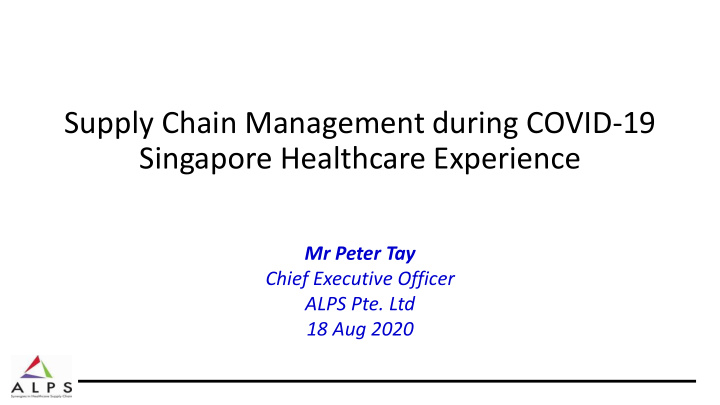



Supply Chain Management during COVID-19 Singapore Healthcare Experience Mr Peter Tay Chief Executive Officer ALPS Pte. Ltd 18 Aug 2020
Scope of Presentation • About ALPS • Situation Landscape • Key Focus Areas • Approach • Reflections ... from a lens of Supply Chain Management
About ALPS • National Healthcare Supply Chain Agency started in July 2018 • Initiated by MOH with 3 Public Healthcare Clusters as ALPS shareholders • Scope : Procurement of Drugs, Medical & Non Medical Supplies, Outsourced Services, Fixture, Furniture & Equipment Supply Chain Operations for all 26 Public Healthcare Institutions.
Situational Landscape w COVID 19 Global National Internal • • • Government imposed prohibitions Detection, treatment & care Availability of Supplies – data o From PHI to community on export on goods extraction & daily/weekly reporting • o External operations Global allocation across all PHIs for o COVID19 related supplies o Medical posts o PPE o ICU equipment & consumables o Private Institutions/Labs/ o Medical Supplies o Lab Supplies & Test equipment o Drugs Service Providers • • o Lab Supplies Factory shutdowns Multi ministry/agencies • • Air freight/air cargo capacity coordination Central management & oversight of • constraints Varying needs assurance of supply • o Lab & clinical preferences o Logistics for lab supplies Regulatory requirements • o Differing workflows o Purchases for advancing stocks MNCs not supporting stockpile o Varying PPE guidelines o MOH Funding development • o Product transfer to PHIs Rapid ramp • o Swabbing Operations Logistics o Lab test capacity o Warehousing • o Distribution services Warehousing & logistics/reverse o Courier services logistics • FW Dorm C+ Infection • Circuit Breaker o Essential Service Providers
Key Focus Areas • Demand-Supply Situation • Risk Assessment and Management • Ensuring care and operations continuity for PHIs Clinical, non-medical and operations demands Accessibility of medications to patients • Supporting national requirements for MOH and agencies • Sustaining and protecting healthcare providers Frontline and Ancillaries
Course of Actions (1/2) • Control Tower & Supply Chain Taskforce Continuous monitoring and assessment of situations o Including abnormalities in demand (leverage on IT and Finance) Command, control, coordinate and communicate activities • Priority : Prevent disruption in supply chain o Diversification of sources, product alternatives, installing buffers Focus on sustenance of critical areas in hospitals o ICU, ISO, ED, ARI and Lab Testing Work with key outsourced partners o Medication deliveries to patients’ home, essential services for hospitals Support facilities external to hospitals o Clusters/ Institutions, AIC, non-PHI labs
Course of Actions (2/2) • Coordination with MOH departments and agencies Establishing demands (MOH departments, agencies and planning groups) Registration (HSA) • Manage demands with MOH, hospitals and suppliers Alternate products Innovation Control of supplies (eg. prescription of medication) • Leverage on capabilities of other ministries and national agencies • Sustenance and protection of healthcare providers
Reflections: What Went Well? • Engagement with clusters/institutions, ministries/agencies Ability to understand situations and needs Facilitates appropriate response and expediency to needs • “Wet Weather” Friends Suppliers & Partners whom we can depend on Strength/quality of relationship during normalcy • Minimised stock out situations • Leadership in resilience, change management
Reflections: Opportunities for Improvements • Visibility of stocks across institutions thru’ key departments Ability to conduct scenario planning • Review of procurement strategies Sole or preferred sources vs diversity • Suppliers’ own visibility of incoming supplies • Improve coordination with national emergency agencies.
Thank You!
Recommend
More recommend